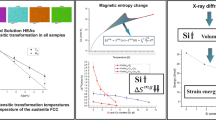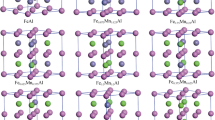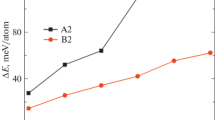Abstract
In the present work, the structural, magnetic, and theoretical analysis of the Fe–Si alloy prepared by melting and heat-treated was performed. The ordered FeSi simple cubic (sc) phase was obtained by melting and heat treatment processes as determined by X-ray diffraction. The presence of the superstructure peak in the (312) crystalline direction confirms the high structural order reached. Using Mössbauer spectrometry (MS), a paramagnetic behavior with quadrupole splitting of SQ = 0.53 ± 0.02 mm/s was obtained. Although MS indicates paramagnetic behavior, vibrating sample magnetometry (VSM) showed ferromagnetic behavior with a coercive field of 25 Oe, associated with a small amount of Fe3Si segregations detected by scanning electron microscopy/energy dispersive spectrometry (SEM/EDS). Using density functional theory (DFT), the crystalline structures for the simple cubic (sc) Fe50Si50, face-centered cubic (fcc) Fe3Si, and body-centered cubic (bcc) Fe3Si crystalline structures were simulated. Electron total density values were calculated to perform energetic comparisons with magnetic behavior. The electronic structures and magnetic properties of the Fe–Si alloys in different stoichiometric configurations were calculated by CASTEP, which employed first principles DFT. The density of states (DOS) and band structures were calculated together with magnetic properties. The results showed that the high value of the polarization spin for the fcc and bcc structures is due to the contribution of the high amount of Fe atoms above the Si atoms, which is reflected in an increase in the magnetic moment and that their presence could explain the ferromagnetic behavior observed by VSM.










Similar content being viewed by others
References
A. Reyes, Y. Arredondo, O. Navarro, First principles study of the effects of disorder in the Sr2FeMoO6 perovskite. Rev. Mex. Física. 62(2),160–163 (2016)
R. Zeller, Spin-polarized DFT calculations and magnetism. Comput. Nanosci. do it yourself 31, 419 (2006)
A. García Escorial et al., Ball milling mechanical alloying in the Fe100-xSix system. Mater. Sci. Eng. A 134, 1394–1397 (1991)
E. Gaffet, N. Malhouroux, M. Abdellaoui, Far from equilibrium phase transition induced by solid-state reaction in the FeSi system. J. Alloys Compd. 194(2), 339–360 (1993)
B. Zuo, T. Sritharan, Ordering and grain growth in nanocrystalline Fe75Si25 alloy. Acta Mater. 53(4), 1233–1239 (2005)
J.F. Piamba, R.R. Rodríguez, G.A. Pérez Alcazar, Mössbauer and xrd study of the Fe0.5 Si0.5 system produced by mechanical alloying and sinterization. Rev. Mex. Física 58(2), 88–92 (2012)
W. Moffatt, in The handbook of binary phase diagrams, ed. by N.Y. Schenectady. General Electric Co. Corporate Research and Development Technology Marketing Operation (1981)
Y. Jing, Y. Xu, J.P. Wang, Fabrication of Heuslar Fe3Si nanoparticles. J. Appl. Phys. 105(7), 1–4 (2009)
M. Shaban, K. Nomoto, S. Izumi, T. Yoshitake, Characterization of near-infrared n-type Β-FeSi2/p-type Si heterojunction photodiodes at room temperature. Appl. Phys. Lett. 94(22), 3–6 (2009)
M. Shaban, H. Kondo, K. Nakashima, T. Yoshitake, Electrical and photovoltaic properties of n-type nanocrystalline-FeSi2/p-type Si heterojunctions prepared by facing-targets direct-current sputtering at room temperature. Jpn. J. Appl. Phys. 47(7 PART 1), 5420–5422 (2008)
E.E. Fullerton et al., Magnetic decoupling in sputtered Fe/Si superlattices and multilayers. J. Appl. Phys. 73(10), 6335–6337 (1993)
A.I. Al-Sharif, M. Abu-Jafar, A. Qteish, Structural and electronic structure properties of FeSi: the driving force behind the stability of the B20 phase. J. Phys. Condens. Matter 13(12), 2807–2815 (2001)
E. Carvajal, R. Oviedo-Roa, M. Cruz-Irisson, O. Navarro, First-principles study of Fe–Mo double perovskites. Rev. Mex. Fis. 58, 171–173 (2012)
R. Masrour, A. Jabar, Ground state and magnetic phase transitions of the spin Lieb nanolattice: Monte Carlo simulations. Phys. A Stat. Mech. Appl. 491, 843–851 (2018)
Y. Gu, J. He, X. Zhan, Z. Ji, Y. Zhang, C. Zhou, Density functional calculations on electronic and magnetic properties of Fe–Pt systems. Mater. Sci. Forum 475–479(IV), 3103–3106 (2005)
V. Cardoso Schwindt, M. Sandoval, J.S. Ardenghi, P. Bechthold, E.A. González, P.V. Jasen, Electronic structure and magnetism on FeSiAl alloy: a DFT study. J. Magn. Magn. Mater. 389, 73–76 (2015)
S. Nazir, N. Ikram, S.A. Siddiqi, Y. Saeed, A. Shaukat, A.H. Reshak, First principles density functional calculations of half-metallic ferromagnetism in Zn1-xCrxS and Cd1-xCrxS. Curr. Opin. Solid State Mater. Sci. 14(1), 1–6 (2010)
J. Teillet, F. Varret, Mosfit Program. Unpublished, University of Le Maine
A.C. Larson, R.B. Von Dreele, General structure analysis system (GSAS). Los Alamos National Laboratory Report (2004)
S.J. Clark et al., First principles methods using CASTEP. Zeitschrift für Kristallographie 220, 567–570 (2005)
M.D. Segall et al., First-principles simulation: ideas, illustrations and the CASTEP code. J. Phys. Condens. Matter 14(11), 2717–2744 (2002)
A.D. Corso, A.M. Conte, Spin-orbit coupling with ultrasoft pseudopotentials: application to Au and Pt. Phys. Rev. B 71(11), 115106 (2005)
N.J. Mosey, E.A. Carter, Ab initio evaluation of Coulomb and exchange parameters for DFT+U calculations. Phys. Rev. B Condens. Matter Mater. Phys. 76(15), 155123 (2007)
K. Harun, N.A. Salleh, B. Deghfel, M.K. Yaakob, A.A. Mohamad, DFT + U calculations for electronic, structural, and optical properties of ZnO wurtzite structure: a review. Results Phys. 16, 102829 (2020)
J.F. Piamba, G.A. Pérez Alcázar, Effect of disorder on the structural and magnetic properties of the Fe50Si50 nanostructured system. J. Alloys Compd. 643(S1), S297–S301 (2015). https://doi.org/10.1016/j.jallcom.2014.12.277
W.A. Hines et al., Magnetization studies of binary and ternary alloys based on Fe3Si. Phys. Rev. B 13(9), 4060–4068 (1976)
S. Torkan, A. Ataie, H. Abdizadeh, S. Sheibani, Effect of milling energy on preparation of nano-structured Fe70Si30 alloys. Powder Technol. 267, 145–152 (2014)
G.A. Pasquevich, P.M. Zélis, M.B. Van Fernández Raap, F.H. Sánchez, Hyperfine field temperature dependence of Fe3Si from Mössbauer thermal scans. Phys. B Condens. Matter 354(1), 369–372 (2004)
S. Thamm, J. Hesse, A simple plot indicating interactions between single-domain particles. J. Magn. Magn. Mater. 154(2), 254–262 (1996)
M.K. Horton, J.H. Montoya, M. Liu, K.A. Persson, High-throughput prediction of the ground-state collinear magnetic order of inorganic materials using density functional theory. npj Comput. Mater. (2019). https://doi.org/10.1038/s41524-019-0199-7
Y. Shin, D. Anh Tuan, Y. Hwang, T. Viet Cuong, S. Cho, Formation and ferromagnetic properties of FeSi thin films. J. Appl. Phys. (2013). https://doi.org/10.1063/1.4800839
K.A. Bush et al., Compositional engineering for efficient wide band gap perovskites with improved stability to photoinduced phase segregation. ACS Energy Lett. 3(2), 428–435 (2018)
K.I. Sakai, T. Sonoda, S.I. Hirakawa, K. Takeda, T. Yoshitake, Current-induced magnetization switching in Fe3Si/FeSi2 artificial lattices. Jpn. J. Appl. Phys. 51(2 PART 1), 028004 (2012). https://doi.org/10.1143/JJAP.51.028004
Acknowledgements
The authors would like to thank CENM (Centro de Excelencia en Nuevos Materiales) and Universidad del Valle for their financial support through research project “Study of FeSi (sc) phase and electronic simulation by DFT”. R. Hernández Bravo and J.M González Carmona thanks to Dirección de Cátedras CONACyT for the financial support granted during the elaboration of this manuscript.
Author information
Authors and Affiliations
Corresponding author
Ethics declarations
Conflict of interest
The authors declare that they have no conflict of interest.
Additional information
Publisher's Note
Springer Nature remains neutral with regard to jurisdictional claims in published maps and institutional affiliations.
Rights and permissions
About this article
Cite this article
Piamba, J.F., Ortega, C., Hernández-Bravo, R. et al. Theoretical and experimental study of FeSi on magnetic and phase properties. Appl. Phys. A 126, 849 (2020). https://doi.org/10.1007/s00339-020-04038-8
Received:
Accepted:
Published:
DOI: https://doi.org/10.1007/s00339-020-04038-8




